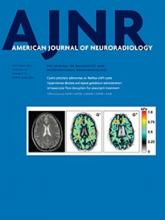Index by author
Lang, S.
- NeurointerventionYou have accessDynamic Angiography and Perfusion Imaging Using Flat Detector CT in the Angiography Suite: A Pilot Study in Patients with Acute Middle Cerebral Artery OcclusionsT. Struffert, Y. Deuerling-Zheng, S. Kloska, T. Engelhorn, S. Lang, A. Mennecke, M. Manhart, C.M. Strother, S. Schwab and A. DoerflerAmerican Journal of Neuroradiology October 2015, 36 (10) 1964-1970; DOI: https://doi.org/10.3174/ajnr.A4383
Lanzino, G.
- NeurointerventionYou have accessChanging Clinical and Therapeutic Trends in Tentorial Dural Arteriovenous Fistulas: A Systematic ReviewD. Cannizzaro, W. Brinjikji, S. Rammos, M.H. Murad and G. LanzinoAmerican Journal of Neuroradiology October 2015, 36 (10) 1905-1911; DOI: https://doi.org/10.3174/ajnr.A4394
Law, M.
- Research PerspectivesOpen AccessHot Topics in Research: Preventive Neuroradiology in Brain Aging and Cognitive DeclineC.A. Raji, H. Eyre, S.H. Wei, D.E. Bredesen, S. Moylan, M. Law, G. Small, P.M. Thompson, R.M. Friedlander, D.H. Silverman, B.T. Baune, T.A. Hoang, N. Salamon, A.W. Toga and M.W. VernooijAmerican Journal of Neuroradiology October 2015, 36 (10) 1803-1809; DOI: https://doi.org/10.3174/ajnr.A4409
Lawton, M.T.
- EDITOR'S CHOICENeurointerventionYou have accessProgressive versus Nonprogressive Intracranial Dural Arteriovenous Fistulas: Characteristics and OutcomesS.W. Hetts, T. Tsai, D.L. Cooke, M.R. Amans, F. Settecase, P. Moftakhar, C.F. Dowd, R.T. Higashida, M.T. Lawton and V.V. HalbachAmerican Journal of Neuroradiology October 2015, 36 (10) 1912-1919; DOI: https://doi.org/10.3174/ajnr.A4391
Of 579 patients with intracranial dural arteriovenous fistulas, 545 had 1 fistula and 34 (5.9%) had enlarging, de novo, multiple, or recurrent fistulas. Of those 34 patients, 19 had progressive dural arteriovenous fistulas with de novo fistulas or fistula enlargement. Angioarchitectural correlates to chronically elevated intracranial venous pressures, such as venous sinus dilation and pseudophlebitic cortical venous pattern, were more common in progressive disease. Three young patients died despite endovascular, surgical, and radiosurgical treatments.
Lee, S.-H.
- Adult BrainOpen AccessIndependent Poor Prognostic Factors for True Progression after Radiation Therapy and Concomitant Temozolomide in Patients with Glioblastoma: Subependymal Enhancement and Low ADC ValueR.-E. Yoo, S.H. Choi, T.M. Kim, S.-H. Lee, C.-K. Park, S.-H. Park, I.H. Kim, T.J. Yun, J.-H. Kim and C.H. SohnAmerican Journal of Neuroradiology October 2015, 36 (10) 1846-1852; DOI: https://doi.org/10.3174/ajnr.A4401
Lee, S.-K.
- FELLOWS' JOURNAL CLUBAdult BrainYou have accessDifferentiation between Cystic Pituitary Adenomas and Rathke Cleft Cysts: A Diagnostic Model Using MRIM. Park, S.-K. Lee, J. Choi, S.-H. Kim, S.H. Kim, N.-Y. Shin, J. Kim and S.S. AhnAmerican Journal of Neuroradiology October 2015, 36 (10) 1866-1873; DOI: https://doi.org/10.3174/ajnr.A4387
This is a retrospective study that included 54 patients with a cystic pituitary adenoma and 28 patients with a Rathke cleft cyst who underwent MR imaging followed by surgery. Regression analysis showed that cystic pituitary adenomas and Rathke cleft cysts could be distinguished on the basis of the presence of a fluid-fluid level, septation, an off-midline location, and the presence of an intracystic nodule.
Leishangthem, L.
- EDITOR'S CHOICENeurointerventionYou have accessMeta-Analysis of CSF Diversion Procedures and Dural Venous Sinus Stenting in the Setting of Medically Refractory Idiopathic Intracranial HypertensionS.R. Satti, L. Leishangthem and M.I. ChaudryAmerican Journal of Neuroradiology October 2015, 36 (10) 1899-1904; DOI: https://doi.org/10.3174/ajnr.A4377
The authors performed a PubMed search of all peer-reviewed articles from 1988–2014 for patients who underwent a procedure for medically refractory idiopathic intracranial hypertension. The CSF diversion procedure analysis included 435 patients. Postprocedure in this group, there was improvement of vision in 54%, headache in 80%, and papilledema in 70%. The dural venous sinus stenting analysis included 136 patients. In this group, after intervention, there was improvement of vision in 78%, headache in 83%, and papilledema in 97% of patients. The current clinical paradigm of CSF diversion first should be re-examined given the good technical success and low complication rates of stenting.
Lell, M.
- Head and Neck ImagingYou have accessImproved Image Quality in Head and Neck CT Using a 3D Iterative Approach to Reduce Metal ArtifactW. Wuest, M.S. May, M. Brand, N. Bayerl, A. Krauss, M. Uder and M. LellAmerican Journal of Neuroradiology October 2015, 36 (10) 1988-1993; DOI: https://doi.org/10.3174/ajnr.A4386
Li, R.S.
- Adult BrainOpen AccessCytotoxic Edema in Posterior Reversible Encephalopathy Syndrome: Correlation of MRI Features with Serum Albumin LevelsB. Gao, B.X. Yu, R.S. Li, G. Zhang, H.Z. Xie, F.L. Liu and C. LvAmerican Journal of Neuroradiology October 2015, 36 (10) 1884-1889; DOI: https://doi.org/10.3174/ajnr.A4379
Li, T.
- Adult BrainOpen AccessGray Matter Volume Reduction Is Associated with Cognitive Impairment in Neuromyelitis OpticaQ. Wang, N. Zhang, W. Qin, Y. Li, Y. Fu, T. Li, J. Shao, L. Yang, F.-D. Shi and C. YuAmerican Journal of Neuroradiology October 2015, 36 (10) 1822-1829; DOI: https://doi.org/10.3174/ajnr.A4403








